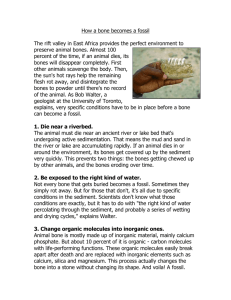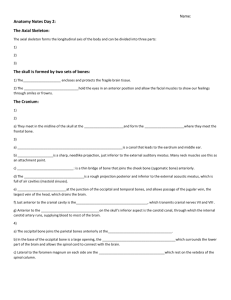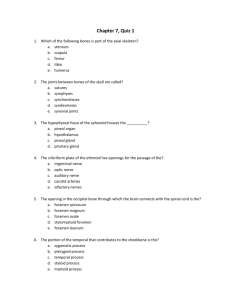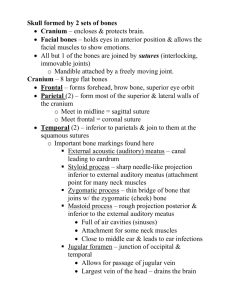The Axial Skeleton
advertisement
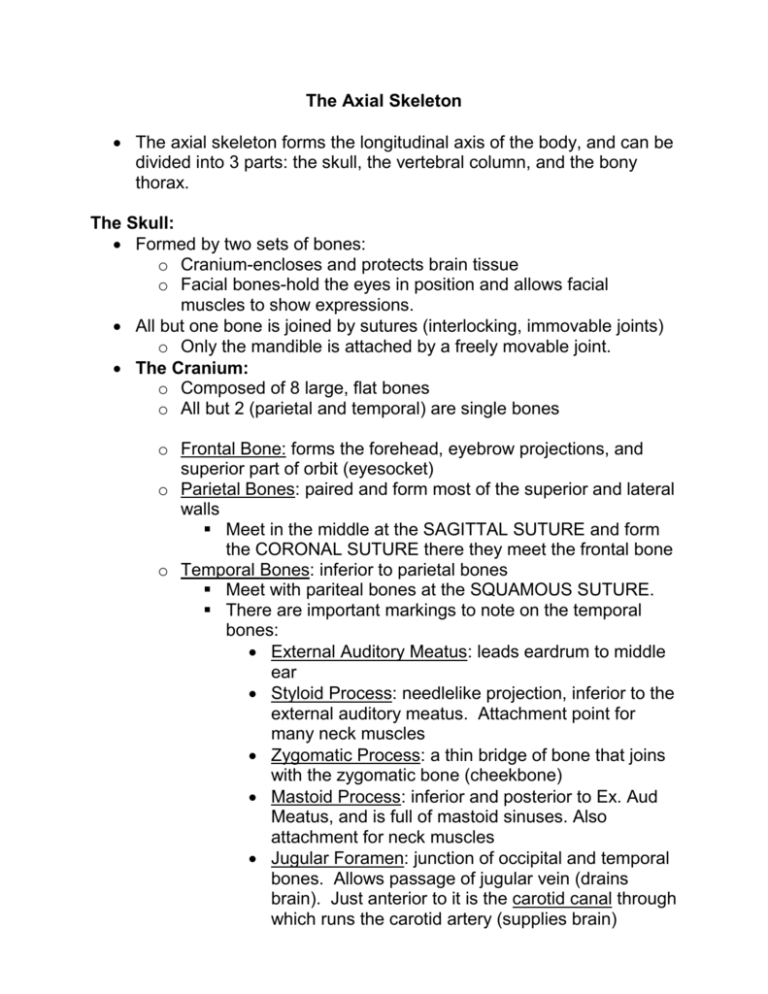
The Axial Skeleton The axial skeleton forms the longitudinal axis of the body, and can be divided into 3 parts: the skull, the vertebral column, and the bony thorax. The Skull: Formed by two sets of bones: o Cranium-encloses and protects brain tissue o Facial bones-hold the eyes in position and allows facial muscles to show expressions. All but one bone is joined by sutures (interlocking, immovable joints) o Only the mandible is attached by a freely movable joint. The Cranium: o Composed of 8 large, flat bones o All but 2 (parietal and temporal) are single bones o Frontal Bone: forms the forehead, eyebrow projections, and superior part of orbit (eyesocket) o Parietal Bones: paired and form most of the superior and lateral walls Meet in the middle at the SAGITTAL SUTURE and form the CORONAL SUTURE there they meet the frontal bone o Temporal Bones: inferior to parietal bones Meet with pariteal bones at the SQUAMOUS SUTURE. There are important markings to note on the temporal bones: External Auditory Meatus: leads eardrum to middle ear Styloid Process: needlelike projection, inferior to the external auditory meatus. Attachment point for many neck muscles Zygomatic Process: a thin bridge of bone that joins with the zygomatic bone (cheekbone) Mastoid Process: inferior and posterior to Ex. Aud Meatus, and is full of mastoid sinuses. Also attachment for neck muscles Jugular Foramen: junction of occipital and temporal bones. Allows passage of jugular vein (drains brain). Just anterior to it is the carotid canal through which runs the carotid artery (supplies brain) o Occipital Bone: the most posterior bone of the cranium Meets with the Parietal bones at the Lambdoid suture. In the base, is the Foramen Magnum (large hole) where it surrounds the lower part of the brain and allows the spinal cord to connect with the brain. Lateral (on the sides) to the Foramen magnum lie the Occipital condyles which lie on the first vertebra of the spinal column. o Sphenoid Bone: butterfly shaped spans the width of the skull and forms part of the floor of the cranium In its midline is the Sella Turcica (Turk’s saddle) which holds the pituitary gland in place The Foramen Ovale, is a large opening in line with the sella turcica that allows the passage of the cranial nerve V to pass to the mandible muscles Sphenoid bones also forms the back of the orbits, and the lateral part of the skull. In the interior of the skull, there are many air cavities called the sphenoid sinuses. o Ethmoid Bone: irregularly shaped and lies anterior to the sphenoid. Forms the roof of the nasal cavity and part of the medial walls of the orbits Projecting from its superior surface is the crista galli, which is where the outermost projection of the brain attaches. On each side the the crista are the cribriform plates (holey areas) that allow fibers carrying impulses from the olfactory (smell) receptors of the nose to reach the brain. Facial Bones: o 14 bones make up the face (12 paired; mandible & vomer are single) o Maxillae: 2 maxillae or maxillary bones fuse to form upper jaw All facial bones, except the mandible, join to the maxillae Carry the upper teeth Projections are called Palatine processes, which form the anterior part of the Palate. Also contain sinuses called Paranasal sinuses, which drain into nasal passages They surround nasal passages, lighten skull bones, and amplify the sounds we make when we speak. This is where sinusitis is common! Because it is continuous with the nasal passages. o Palatine Bones: lie posterior to palatine process of the Maxillae (back end) o Zygomatic Bones: cheekbones and a good portion of the lateral walls of the orbits o Lacrimal Bones: fingernail sized bones that form the medial walls of each orbit. Has a groove to serve as a passage way for tears (Spanish-lagrimas) o Nasal Bones: small rectangular bones forming the bridge of the nose (lower part is cartilage) o Vomer Bone: single bone in the median line of the nasal cavity, forming most of the septum. o Inferior Conchae: thin curved bones projecting from the lateral walls of the nasal cavity (superior and middle conchae are part of the ethmoid bone) o Mandible: lower jaw, and is the largest and strongest bone in the face. Joins the temporal bones on each side, making the only freely moving joints in the face. Carry lower teeth o Hyoid Bone: Not considered part of skull, it is the only bone in the body that is not connected directly to another bone. It is suspended in the midneck region about 2cm above the larynx, where it is anchored to the styloid process Serves at a movable base for the tongue and attachment point for neck muscles that influence the larynx (voicebox) Fetal Skull: o The fetal skull is very large compared to the rest of its body. It is ¼ of the total body length, where in an adult it is 1/8. o There are cartilaginous regions that have yet to be converted to bone. o Theses areas where the bones have not connected are called fontanels (soft spots). The fontanels enabled compression during birth and allow the baby’s brain to grow. Are gradually converted to bone by about 2 yrs of age.





